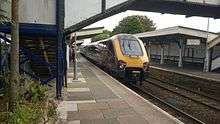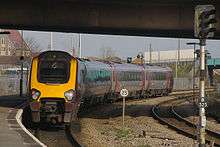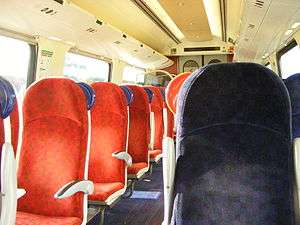British Rail Class 220
| British Rail Class 220 Voyager | |
|---|---|
|
CrossCountry 220002 passes Charfield on a Birmingham New St-Plymouth service. | |
|
The interior of standard class on board a CrossCountry Class 220 | |
| In service | 2001 — |
| Manufacturer | Bombardier Transportation |
| Built at | Bruges, Belgium |
| Family name | Voyager |
| Constructed | 2000–2001 |
| Number built | 34 trainsets |
| Number in service | 34 trainsets |
| Formation | 4 cars per trainset |
| Capacity | 174 standard class, 26 first class |
| Operator(s) | CrossCountry |
| Specifications | |
| Car body construction | Steel |
| Car length | 23.85 m (driving cars) or 22.82 m (intermediate cars) |
| Width | 2.73 m (8 ft 11 in) |
| Articulated sections | Flexible diaphragm (within unit only) |
| Maximum speed | 125 mph (200 km/h) |
| Weight | 185.6 t (182.7 long tons; 204.6 short tons) per trainset |
| Traction system | DEMU |
| Prime mover(s) | Cummins QSK19[1] |
| Power output |
Each engine: 560 kW (750 hp) at 1800 rpm Total: 3,000 hp (2,240 kW) |
| Transmission | Diesel-electric |
| UIC classification | 1A'A1'+1A'A1'+1A'A1'+1A'A1'[2][3] |
| Braking system(s) | Rheostatic |
| Safety system(s) | AWS, TPWS |
| Coupling system | Dellner[4] |
| Track gauge | 1,435 mm (4 ft 8 1⁄2 in) |
The Class 220 Voyager is a class of diesel-electric high-speed multiple-unit trains built in Belgium by Bombardier Transportation in 2000 and 2001.
They were introduced in 2001 to replace the 30-year-old InterCity 125 and Class 47 fleets operating on the Cross Country Route, initially for Virgin Trains and since 2007 by CrossCountry.[5]
Technical details
All coaches are equipped with a Cummins QSK19 diesel engine of 750 hp (560 kW) at 1800rpm. These power a generator which supplies current to motors driving two axles per coach,[6] with one axle per bogie powered.[7][8]
Voyagers have both air and rheostatic brakes. They are fitted with Dellner couplers, like the Class 222, operated by East Midlands Trains and the Class 390 Pendolino electric trains used by Virgin West Coast meaning they can be coupled in rescue/recovery mode (air brake only) in the event of a failure. 220s and 221s can also be easily assisted by Dellner fitted Class 57s (Thunderbirds) in the event of a failure. By use of adaptive couplings a failed 220 or 221 can also be assisted by any air braked locomotive such as a Class 37, 47 or 66 or even an HST. The units can work in multiple with Class 221 units but not Class 222 units as the electrical connections of the Class 222 units are incompatible with the Class 220.
The Class 220s and closely related Class 222s have B5005 bogies,[2][7] which are distinctive as they are of inside-frame design and so the axles are supported by bearings behind the wheels, meaning the outside face of the wheel is visible. The related Class 221 Super Voyager has outside-frame bogies and hence a more conventional appearance.
The Class 220s operate in four-coach sets with a carriage mass of between 45 and 48 tonnes and a total train weight of 185.6 tonnes, a top speed of 125 mph (200 km/h) and a maximum range of approximately 1,350 miles (2,170 km) between each refuelling. Their route availability is very good being RA 2[6] - in part due to the lightweight bogie design.
Class 220 units do not have automatic sanding equipment, and instead have "one-shot" sanders which activate when all of the following conditions are met:
- The emergency stop button has been pressed;
- Wheel slip has been detected;
- Train speed is over 8 miles per hour (13 km/h).
As it was necessary to take the train out of service for refill following the deployment of sand, Bombardier fitted a second sand bottle, allowing two uses before the train would need to be withdrawn from service. The CrossCountry fleet was modified between February and June 2011.[9]
All Voyagers are maintained at the dedicated Central Rivers TMD near Burton-on-Trent.
Accidents and incidents
Units have sometimes been stopped by salt water, when storm-driven waves broke over the train at Dawlish in south Devon and inundated the resistor banks, causing the control software to shut down.[10] This problem was fixed by an upgrade to the control software.[11]
There were a number of exhaust fires on the Voyager class during 2005–2006 due to incorrect fitting of equipment during overhauls. Fires occurred at Starcross (Class 221), Newcastle and on 19 January 2006 at Congleton.[12]
On 14 March 2008, 220 012, forming a service to Derby, had a roof fire at Banbury.[13][14] This fire was caused by a bird getting caught under one of the hot brake resistors on the roof of the train. Damage to the train was not serious and it was repaired and returned to service.
Formation and passenger facilities
Class 220s operate in four-coach sets. These trains, unlike the older trains they replaced, feature electronic information boards on the exterior walls showing the train number, the time, the coach, the train's destination, and the next station. This is also a feature of the Class 221 and Class 222 trains (The Class 390 trains have such electronic information boards, but in the doors). They are air-conditioned throughout, with powered doors. The coaches are fitted with power sockets for laptop computers and mobile phone charging. Toilet facilities for disabled people and storage facilities for bicycles are provided.
They provide 26 seats in 2+1 formation in first class and 174 seats in 2+2 formation in standard class.
The formation of a four-car Class 220 is as follows:[1]
- 604## - Coach A - 26 seats - First Class with disabled area, train manager office, first class catering area and driving cab. Toilet.
- 602## - Coach C - 66 seats - Standard Class. Toilet.
- 607## - Coach D - 66 seats - Standard Class with large luggage area and reservable space for three bikes. No toilet.
- 603## - Coach F - 42 seats - Standard Class with disabled area, catering base and driving cab. Toilet.
There is no coach B on the four car class 220, it exists on the 5-car class 221 and is usually a coach which holds no reservations. This aids short-term fleet changes, for example if a class 220 is running in a diagram that usually has a class 221, then the loss of a coach will not affect the reservation system, as they will all still be allocated. CrossCountry has finished updating the interior layout of all its 220 and 221 sets; the aim is to increase seating capacity, in line with its commitments to the franchise agreements, as well as provide an at-seat trolley service for refreshments instead of a shop. Research had shown that the shop was not making as good a turnover as hoped because people prefer not to leave their seats to get refreshments; they feared either losing their seat or having their belongings stolen when away. In Virgin Trains' unsuccessful franchise bid it also cited removal of the shop from 220s and 221s as a way of trying to improve seating capacity.
The interior renovation involved the removal of the shop from coach D and the conversion of the stowage area in coach F to a catering storage area where there is now a fridge, food storage and a space for an on-board trolley to be stored. Bicycle storage has been moved to coach D where the shop was. It can now store three bicycles instead of four.
The Class 220s have been criticised for a number of shortcomings:
- Increased underfloor noise and vibration when compared to the non-powered Mark 2 and Mark 3 coaching stock they replaced due to the underfloor diesel engines.
- As the profile of the bodyshells is designed to allow clearance for tilting (although the Class 220s have never featured tilting capability, they use the same shell as the Class 221), the interior space is reduced when compared with conventional carriages.
- The four-car sets are typically shorter than the trains they replaced (usually a locomotive with 7 coaches or a 7-car HST)- despite more frequent running, overcrowding is still a problem especially with the increase in passenger numbers. A feasibility study into adding another coach to each Voyager was looked at by the Department For Transport jointly with Crosscountry and Bombardier. This coach would have had a pantograph and conversion equipment instead of a diesel engine, providing the Voyager units (Classes 220 and 221) with dual traction capability (diesel/electric and electric 25 kV). However, it was not considered cost-effective.
- There is little to no space to store large luggage items or bikes. More luggage space has been provided in the converted CrossCountry units with the removal of the shop. The conversion has however resulted in only three bicycle spaces instead of the original four.
- Most seating is in 'airline' configuration, with pull-down trays which are too small to use a large laptop on, but are fine for smaller laptops and netbooks.
Operation





All units are owned by Voyager Leasing, a consortium of Lloyds Banking Group and Angel Trains.[15] They are leased to the train operating companies; as of 2013, CrossCountry is the only operator of Class 220 units.
Virgin Trains was the sole operator of Class 220 Voyager trains when they were introduced in 2001, via their Virgin West Coast and Virgin CrossCountry franchises. When the Cross Country Route franchise was transferred to Arriva CrossCountry in November 2007, most of the Voyager fleet was transferred with it, and by the end of 2007 CrossCountry was the sole operator of Class 220 units.
The 220s often operate in multiple with Class 221 units, which are mechanically similar except for their bogies and have the same coupler type.
Fleet details
There are 34 Class 220 Voyager trains, numbered 220 001–220 034.
| Class | Operator | Number | Year Built | Cars per Set | Unit Numbers. |
|---|---|---|---|---|---|
| Class 220 | CrossCountry | 34 | 2000–2001 | 4 | 220 001–220 034 |
Virgin Trains named all the Class 220 Voyagers after places that they serve or companies that have relations with Virgin Trains.
| 220 001 | Somerset Voyager (previously Maiden Voyager) | 220 018 | Dorset Voyager (previously Central News) |
| 220 002 | Forth Voyager | 220 019 | Mersey Voyager |
| 220 003 | Solent Voyager | 220 020 | Wessex Voyager |
| 220 004 | Cumbrian Voyager (previously New Dawn) | 220 021 | Staffordshire Voyager (previously Blackpool Voyager) |
| 220 005 | Guildford Voyager | 220 022 | Brighton Voyager |
| 220 006 | Clyde Voyager | 220 023 | Mancunian Voyager |
| 220 007 | Thames Voyager | 220 024 | Sheffield Voyager |
| 220 008 | Welsh Dragon | 220 025 | Severn Voyager (previously Virgin Voyager) |
| 220 009 | Gatwick Voyager | 220 026 | Stagecoach Voyager |
| 220 010 | Ribble Voyager | 220 027 | Avon Voyager |
| 220 011 | Tyne Voyager | 220 028 | Black Country Voyager |
| 220 012 | Lanarkshire Voyager | 220 029 | Cornish Voyager |
| 220 013 | South Wales Voyager | 220 030 | Devon Voyager |
| 220 014 | South Yorkshire Voyager | 220 031 | Tay Voyager |
| 220 015 | Solway Voyager | 220 032 | Grampian Voyager |
| 220 016 | Midland Voyager | 220 033 | Fife Voyager |
| 220 017 | Bombardier Voyager | 220 034 | Yorkshire Voyager |
When the Class 220s were transferred to the new operator CrossCountry, all the names were removed. All Class 220 Voyagers are now in CrossCountry livery.[16]
See also
References
- 1 2 Diesel Multiple Units 2010. Sheffield: Platform 5. 2010. p. 66. ISBN 978-1-902336-75-6.
- 1 2 "High-speed multiple units Virgin Voyager and Super Voyager with SK-450 final drives and cardan shafts" (PDF). Voith. May 2008. pp. 1–2. Retrieved 13 March 2008.
Drive configuration [diagram]
- ↑ "Cutting noise and smoothing the ride". Railway Gazette. London. 1 August 2000. Retrieved 20 December 2010.
In the Voyager application, every car has a Cummins underfloor engine and alternator supplying power to a pair of body-mounted traction motors. Each drives one inner axle through a cardan shaft and axle-mounted final drive gearbox. Thus all 272 bogies are identical
- ↑ "Mechanical And Electrical Coupling Index". Rail Safety and Standards Board. Archived from the original on 21 December 2013. Retrieved 20 December 2010.
- ↑ "New Dawn for Virgin Trains" (Press release). Virgin Trains. 5 June 2001. Retrieved 13 February 2009.
- 1 2 "Class 220 data". The Railway Centre. 2 June 2008.
- 1 2 M-Size Bogies B5000 For Coach and EMU Applications
- ↑ B5000 bogies bombardier Archived 17 January 2016 at the Wayback Machine.
- ↑ "Buffer stop collision at Chester station 20 November 2013" (PDF). Rail Accident Investigation Branch. November 2014. pp. 5, 9, 29–30. Retrieved 24 November 2014.
- ↑ "Virgin Trains chaos 'over by Christmas'". BBC News. 20 November 2002.
- ↑ "Voyager Train fleet "think smart" to operate past Devon sea storms" (Press release). Virgin Trains. 2 December 2002. Archived from the original on 16 October 2006.
- ↑ Virgin Trains Cross Country news April 2006. Page 4 section 14 Archived 26 September 2006 at the Wayback Machine.
- ↑ "Train fire at Banbury". Banbury Guardian. 14 March 2008. Retrieved 13 February 2009.
- ↑ "Train Fire is out". Oxford Mail. 14 March 2008.
- ↑ Pritchard, Robert; Hall, Peter (2013). British Railways Locomotives & Coaching Stock 2013. Sheffield: Platform 5 Publishing. pp. 245–6, 373. ISBN 978-1-909431-02-7.
- ↑ Class 220 Fleet Details
External links
| Wikimedia Commons has media related to British Rail Class 220. |
- Diesel Electric Multiple Unit, Class 220 “Voyager” - United Kingdom Bombardier Class 220 page
- Testing the Class 220s
.jpg)
